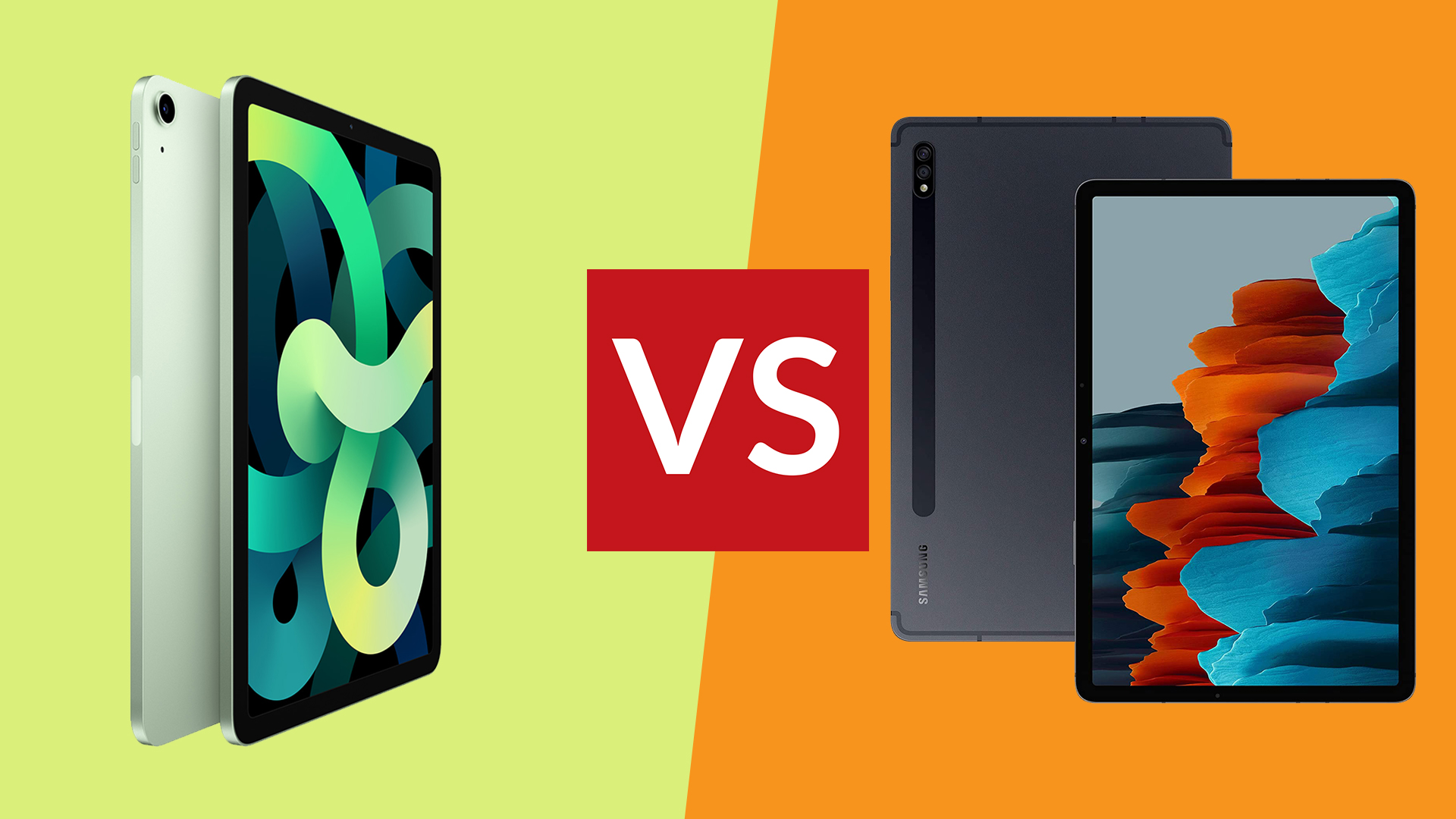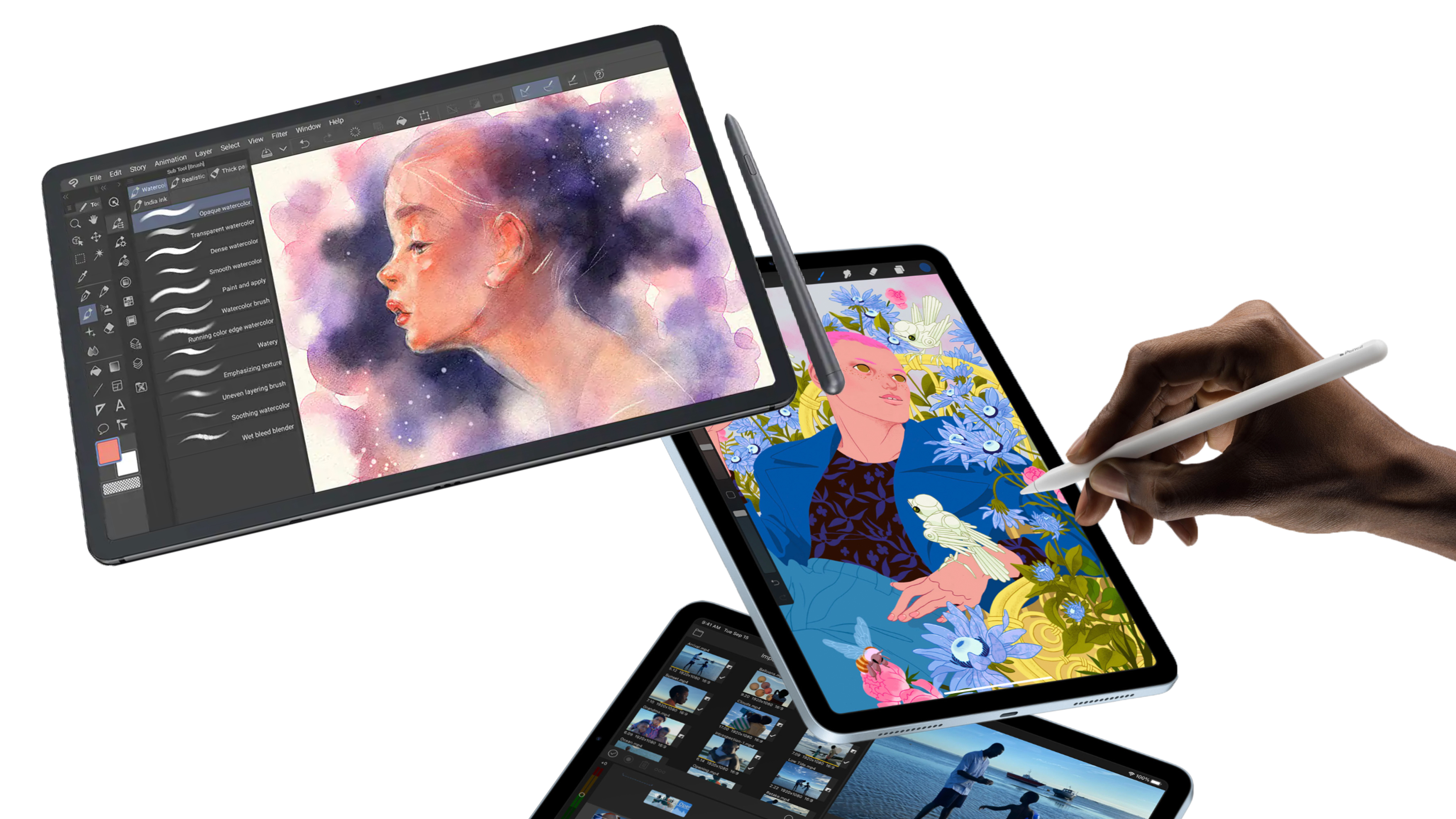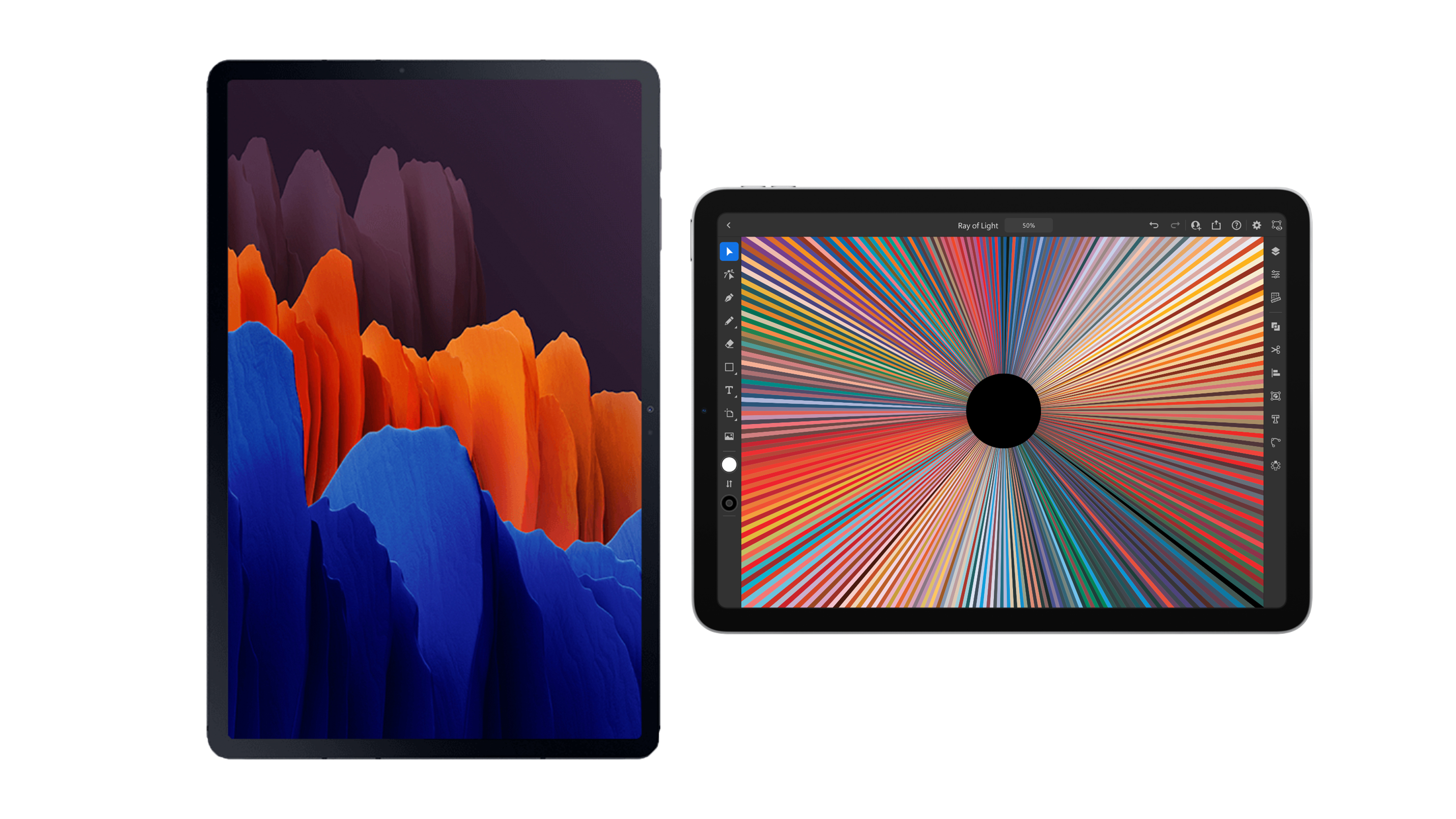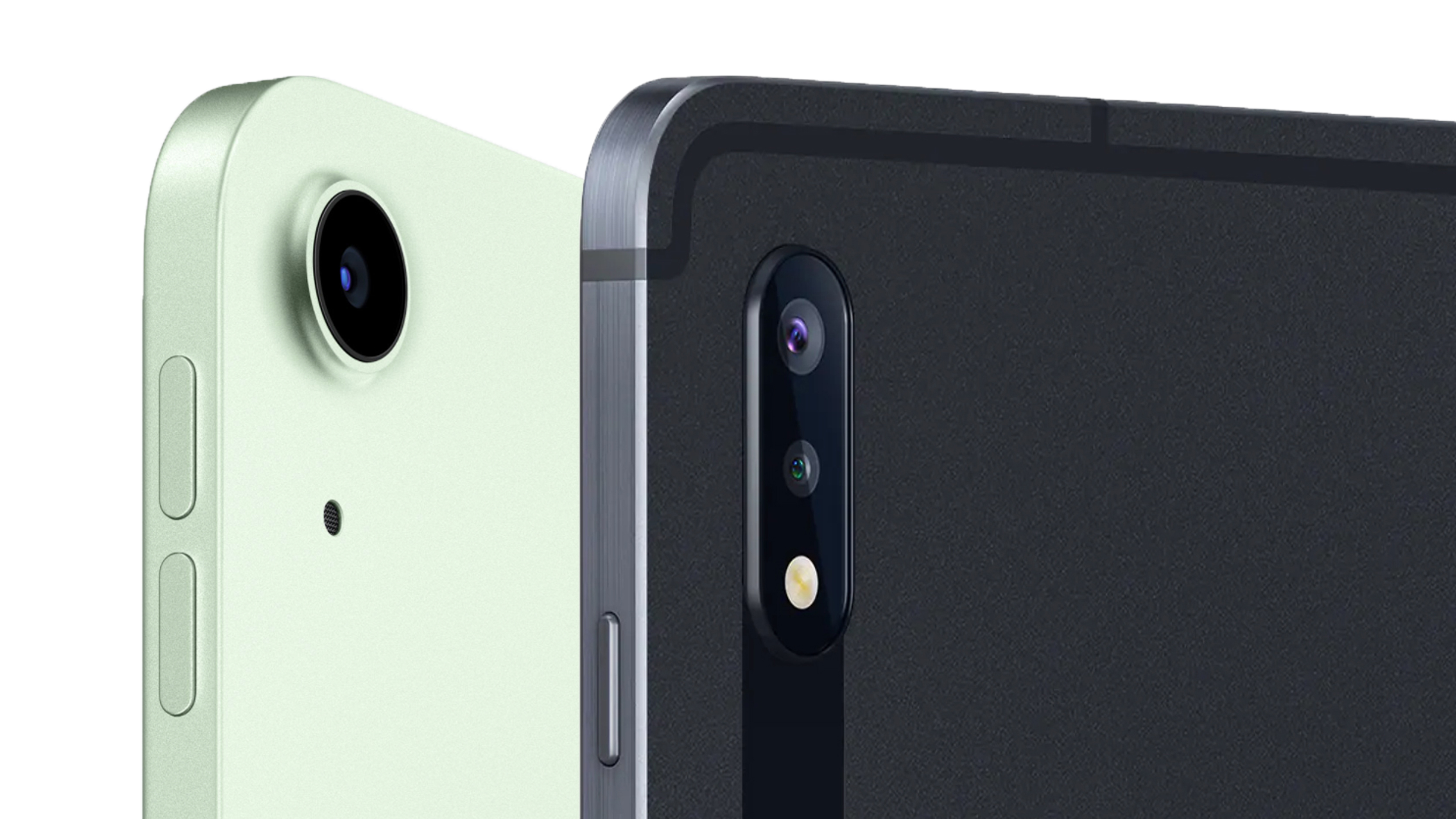Apple iPad Air (2020) vs Samsung Galaxy Tab S7+: which mid-range tablet is best for you?
Two of the best tablets from Apple and Android face off to see who’s the top dog for sleek mid-range slates


In the battle of the best tablets, pitting Apple’s iPad Air (2020) against Samsung's Galaxy Tab S7+ might seem unfair at first since the latter is really more of an iPad Pro rival in terms of price… but the Samsung comes with a stylus, and adding an Apple Pencil to the iPad Air suddenly brings its price much closer to the Samsung tablet.
Beyond that, these two tablets offer vastly different ecosystems, and while Apple's iPadOS has proven to offer a much more seamless experience and effortless user interface – not to mention, better-optimised apps for the big screen – your choice will still boil down to personal taste as well as whatever ecosystem you’re already invested in.
However, seeing as these two devices are the top tablet releases of 2020, aiming very much for the same kind of user, those who have been considering investing in a tablet or upgrading their existing ones would want to know which of the current models is the cream of the crop.
From their power and performance to their displays and ports to their price tags, we’ve set these two 2020 tablets side by side to help you decide. Neither’s going to come out the ultimate winner, as each has its own strengths and weaknesses. But, it will at least help you decide which one is best for you.

iPad Air (2020) vs Samsung Galaxy Tab S7+: Price
Already you’ll see a massive difference between these two devices when you compare their prices of entry. The iPad Air (2020) was certainly the more affordable prospect at launch, its lowest Wi-Fi configuration setting you back £579/$599/AU$899 and the base cellular model starting at £709/$729/AU$1,099. Both give you 64GB of storage and the A14 Bionic chip.
For the bigger storage space of 256GB, the iPad Air (2020) Wi-Fi model costs £729/$749/AU$1,129 while the cellular one costs £859/$879/AU$1,329.
Meanwhile, the base configurations for the Samsung Galaxy Tab S7+ are at least a couple hundred pounds/dollars more at £799/$849/$1,549 for the Wi-Fi model and £999/$1049/AU$1,749 for the cellular model. That’s actually not bad considering you’re getting twice the storage (128GB) and more RAM. While Apple hasn’t specified how much memory the iPad Air has, it is said to be around 4GB – less than the Tab S7+’s 6GB and 8GB offerings (though RAM size comparisons are harder to make in tablets than laptops).
Get all the latest news, reviews, deals and buying guides on gorgeous tech, home and active products from the T3 experts
However, we already mentioned that the Samsung comes with a stylus, while buying the Apple Pencil 2 for the iPad costs £119/$129/AU$199. When you then factor in that the Samsung is regularly available for much less than its given price, the costs of the two tablets get a lot closer. Of course, you have the option of just not getting the Apple Pencil for the iPad if you don't need it.
Though unavailable in the UK and the US at the time of writing, the Samsung Galaxy Tab S7+ does have a 256GB model available in Australia at AU$1,749 for the Wi-Fi and AU$2,049 for the cellular one.

iPad Air (2020) vs Samsung Galaxy Tab S7+: Design and features
The Samsung Galaxy Tab S7+ is noticeably much bigger than the iPad Air (2020). It certainly dwarfs iPad Air’s 178.5x247.6x6.1mm frame at 185x285x5.7mm so the fact that it’s thinner than Air isn’t as impressive here due to its bigger frame. Naturally, it has a bigger 12.4-inch display (next to the Air’s 10.9 inches), though the fact that it's 115g heavier is kind of disappointing.
To be fair, the point of the iPad Air (2020) is to offer a lighter and more compact tablet option, though that’s not the only advantage it has over the Tab S7+. It’s 4:3 screen ratio gives more space for browsers and apps in portrait mode, while its Touch ID built into the top button is fast and responsive. The screen is 2360x1640, and is an LCD panel with a 60Hz refresh rate, P3 colour gamut and Apple's excellent True Tone tech, which adjust the color temperature to match the ambient lighting in the room, so it's more pleasant to read on.
Fun colour options are also on hand for those who prefer brighter colours. On top of the silver and space, grey shades are rose gold, green, and sky blue.
As for the Samsung Galaxy Tab S7+, its 12.4-inch Super AMOLED screen boasts a slightly higher resolution of 2800x1752, a refresh rate of 120Hz, and an aspect ratio of 16:10 that’s better for watching video content. Its AMOLED screen also offers deeper contrast than the iPad Air manages, making it stronger for video overall.
While the Air does offer Apple Pencil (2nd generation) support, you have to pay an extra £119/$129/AU$199 – that’s a considerable amount considering you’re already paying several hundred pounds/dollars for the device. The Tab S7+, on the other hand, already has the Samsung S Pen stylus in the box, and it magnetically attaches to the glass strip in the tablet’s rear for charging and safekeeping.
The iPad also uses magnetic attachment and charging for the Pencil, and this happens on the flat edge of the device rather than the rear – we prefer that arrangement.
The iPad Air has a 12MP wide-angle rear camera and a 7MP FaceTime HD front camera, but the Tab S7+ has three, two of which have higher resolutions. There is a 13MP camera as well as a 5MP ultra-wide camera round the back, and an 8MP camera that is located on the right-hand side of the screen so that it sits on top of the screen when in landscape mode, much like it would on a traditional laptop. The last of these is much better for video calls.
For your typing and traditional scrolling needs, both have their own keyboard-and-trackpad accessory available for purchase. The aptly-named Magic Keyboard for iPad Air, at £299/$299/AU$499, boasts among the best keyboard and trackpad we’ve ever tested. Though the Tab S7+’s Keyboard Cover is no slouch either and is cheaper at £219/$229/AU$359.

iPad Air (2020) vs Samsung Galaxy Tab S7+: Specs and performance
While the Samsung Galaxy Tab S7+ owns the iPad Air (2020) in terms of features, the latter may have an edge in terms of performance. The Tab S7+, after all, comes with a Qualcomm Snapdragon 865 Plus processor inside, and though that might be the fastest processor for Android devices, benchmarks have shown the Air’s A14 Bionic chip to be better performing and have better power efficiency.
That means that the Air offers faster and smoother CPU and GPU performance. If you’re an Apple fan, this perhaps won’t come as a surprise, as Apple has honed the art of designing excellent mobile chips.
The iPad Air only has a 7,606mAh battery versus the Tab S7+’s 10,090mAh, which means that the Tab S7+ can outlast it – Samsung claims up to 14 hours of battery life advantage compared the Air’s 10-hour rating. However, that number will be affected by all kinds of things, including what types of app you're running. And Apple's battery numbers are often conservative – we've seen it push past those figures. So while Samsung has the advantage, it isn't a huge one.
Another point for the iPad Air (2020) here is that the iPadOS is simply divine to use, especially now that Apple has given it a redesign as well as add few new features such as widgets (at last). Because the company has worked tirelessly on giving its users a beautiful tablet experience, those apps are incredibly optimized and work smoothly with the interface. Android’s apps, sadly, feel and look on the Android tablet interface like they haven’t seen a proper update since the last decade.
The Samsung Galaxy Tab S7+ does have a slight advantage on storage, however. While the iPad Air (2020) comes with 64GB and 256GB storage, the former not only comes with 128GB or 256GB storage, but also has a slot for a microSD card so you can expand storage to up to 1TB. That’s useful for many creative professionals, though a lot of people may not both with it.
In fact, 256GB of storage would be more than enough for most people. Case in point, this writer takes a lot of images and videos as well as downloads a lot of apps for work and personal use, and has yet to use even half of that 256GB storage.
iPad Air (2020) vs Samsung Galaxy Tab S7+: Verdict
When deciding between the iPad Air (2020) and the Samsung Galaxy Tab S7+, it all boils down to your taste and needs. Again, these top tablets of 2020 have their share of strengths as well as weaknesses.
The Air has the advantage in performance, the seamlessness of interface, and design (we love being able to choose nice colors!), making it ideal for users in the creative and productivity space who want to use their tablet as a secondary work device, but also as an all-round device. Whatever you need to do, there's an excellent app that's optimized for the iPad's larger screen – and the experience of using it generally is just that little bit slicker.
In contrast, the Tab S7+ wins in battery life, storage space, and features like that bigger, more stunning screen – it means that for certain uses, particularly video, but anything that warrants a generous screen and storage (or if a more versatile camera would be useful), the S7+ is a great choice.
As both products are a couple of years older now, however, they can be found new at greatly discounted prices, as you can see below, which makes them all the more tempting than buying the replacements that have since appeared from each brand.

Michelle Rae Uy is a tech and travel journalist, editor and photographer with a bad case of wanderlust. She is a regular contributor for IGN, TechRadar and Business Insider, and has contributed to Thrillist, Paste Magazine, Nylon, Fodor's and Steve's Digicams. Living mainly in California with her adorable cats, she splits her time between Los Angeles, London and the rest of the world.